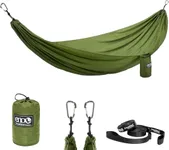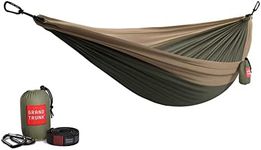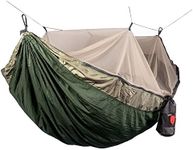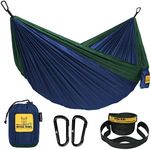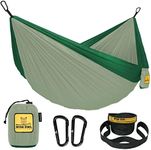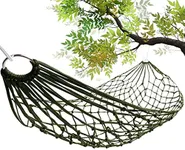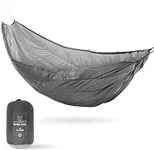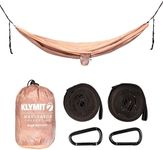Buying Guide for the Best Camping Hammocks
Choosing the right camping hammock can significantly enhance your outdoor experience. A good hammock should provide comfort, durability, and ease of use. When selecting a camping hammock, consider where and how you plan to use it, as well as your personal preferences for comfort and convenience. Here are some key specifications to help you make an informed decision.MaterialThe material of a camping hammock is crucial for comfort, durability, and weather resistance. Common materials include nylon and polyester. Nylon is lightweight, breathable, and quick-drying, making it ideal for warm weather. Polyester is more durable and resistant to UV rays, which is better for long-term use and varied weather conditions. Choose a material based on the climate you'll be camping in and how often you plan to use the hammock.
Weight CapacityWeight capacity refers to the maximum weight a hammock can safely support. This is important for ensuring safety and durability. Hammocks typically range from 250 to 500 pounds in weight capacity. If you plan to use the hammock alone, a lower capacity may suffice. However, if you intend to share the hammock or use it for heavy-duty purposes, opt for a higher weight capacity to ensure it can handle the load.
SizeHammock size affects comfort and usability. Single hammocks are designed for one person and are usually around 4-5 feet wide. Double hammocks are wider, around 5-6 feet, and can accommodate two people or provide extra space for one person. Consider a single hammock if you prefer a snug fit and lightweight gear. Choose a double hammock if you want more space or plan to share it with someone else.
WeightThe weight of the hammock is important for portability, especially if you plan to hike or backpack. Lightweight hammocks can weigh as little as 1 pound, making them easy to carry. Heavier hammocks, which can weigh up to 3 pounds or more, may offer more features or durability but can be cumbersome to transport. Choose a lightweight hammock if you prioritize ease of carrying, and a heavier one if you need additional features or durability.
Suspension SystemThe suspension system includes the straps and carabiners used to hang the hammock. A good suspension system is easy to set up, adjustable, and tree-friendly. Look for systems with wide straps to prevent damage to trees and strong carabiners for secure attachment. Simpler systems are great for beginners, while more advanced systems offer greater adjustability and security for experienced campers.
Bug NetA bug net is an essential feature if you plan to camp in areas with insects. It provides protection from mosquitoes and other bugs, ensuring a comfortable sleep. Some hammocks come with an integrated bug net, while others require a separate purchase. If you camp in bug-prone areas, an integrated bug net can save you time and hassle. If bugs are not a concern, you can opt for a hammock without one.
RainflyA rainfly is a waterproof cover that protects you from rain and wind. It is crucial for camping in unpredictable weather. Some hammocks come with a rainfly, while others require a separate purchase. If you expect wet conditions, a rainfly is a must-have to stay dry and comfortable. If you camp in dry climates, you may not need one, but it's always good to have as a precaution.

